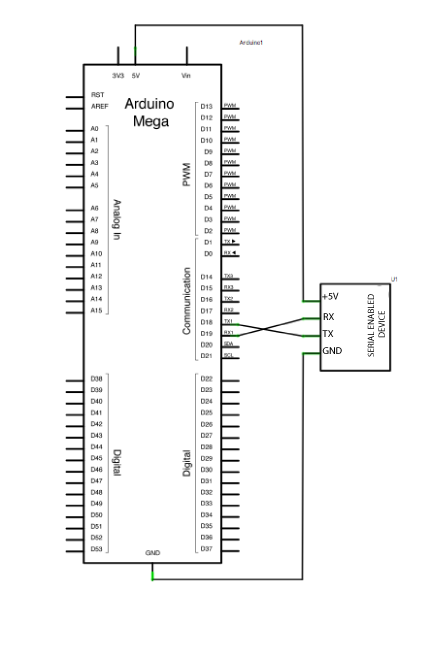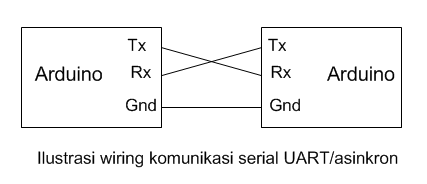Komunikasi Serial Arduino
Nah sekarang kita mencoba kumunikasi serial Arduino untuk menampilkan tulisan 'HelloWorld' pada komputer. Untuk peralatan yang diperlukan cukup dengan Arduino Board saja. Langsung saja kita buat source code programnya untuk arduino. Tulis code berikut ini pada Arduino Software, kalau belum punya download dulu di sini. Komunikasi serial arduino dengan menyalakan 1 led Sebelum kita membuat suatu program rangkaian,kita harus mengetahui dasar dari komunikasi serial,berikut ini saya akan membahas apa itu komunikasi serial serta fungsinya terlebih dahulu sebelum melanjutkan ke pemograman. Adobe acrobat xi pro bittorrent torrent.

Following on from the post, if you do not have a FTDI serial adaptor you can use an Arduino. Here is how to set up the Arduino to talk to the ESP8266.
I an using a 5V Arduino Nano which of course is 5V. The Esp8266 is a 3.3v device and so I am using a voltage divider to bring the Arduinos 5V down to 3.3v. If you are using a 3.3v Arduino then you do not need the voltage divider. The wiring is very similar to the FTDI. Arduino pin 3 to voltage divider and then to ESP8266 RX Arduino pin 2 to ESP8266 TX Arduino GND to ESP8266 GND Pull CH_PD HIGH with a 10K resistor to +3.3v +3.3V to vcc You only need the voltage divider on the Arduino TX pin. The 5V Arduino will read 3.3v as HIGH so you can connect the ESP8266 TX pin directly to the Arduino RX pin. Make sure the ESP8266 has enough current.
If it does not it may keep resetting and may not broadcast a signal. Arduinos cannot supply enough current and you should use a separate power supply. While experimenting I use a bread board power supply. I am using a simple serial in, serial out sketch. Hi Chris, You are correct, the ESP8266 can draw up to 300mA which is too much for the Arduino.
My test projects were all done on a bread board and I used a bread board power supply which can be set to output either 5V or 3.3V. You can see the set up in the FTDI + ESP8266 post – For a permanent project I would use an external power supply (I have a lot of the 9V ones you get with many of the Arduinos). This would give power to the Arduino and also 3.3V, via a regulator, to the ESP8266. I have also started to use small buck convertor power supplies quite a lot. These handle a wide range of input voltages and a wide range of output voltages and can be bought very cheaply. My problem like this: it’s my first time use this module,when i try like your tutorial,, need more than five time i tried,, and i got same like that,, the ESP respones and i can write the command,, but when i try again tomorrow,, ESP don’t respons again like yesterday,, and i must check wiring again and repair it and make sure if my wiring is same. But i cann’t get same respons like yesterday,, i cann’t write command,, ESP just respons stranger word,, i want to know what is the main problem,, is it just about the power of battery,, because every day it’s less and now not 3v again or what??
And i never flash from first time i bought and my battery now is just 2.78V. I want to interface Arduino Uno and ESP8266 for IoT project where i have to control the device from webpage,but before that i wanted to check the above code for Arduino to ESP8266 by Serial Communication.So interfaced Arduino Uno with ESP8266 and powered ESP8266 with External adapter with 3.3V, ESP8266 baud rate is 115200 and in the code i changed Serial.begin(115200) and ESPserial.begin(115200). After i uploaded the above code in Arduino IDE and opened serial monitor,made both NL and CR but i got the message saying ” Remember to set Both NL & CR in the serial monitor. Ready ” After that no response.I tried with different baud rates and also typed AT,but no response.

Can you please suggest. If using a 3.3v Arduino you connect direct. No need the voltage divider.
I presume this is how you have it connected. It sounds like you may have the baud rate too high? If using software serial, try AltSoftSerial. If using a high baud rate bring it down a bit.
Fedorako_Praktikum_Po_Matematike_Dlya_Podgotovki_K_TSt_ Reshebnik _RQ3RO9.exe [磁力链接] 软件 创建时间: 2018-12-23 文件大小: 1.24 MB 文件数量: 1 下载热度: 2 最近下载: 1个月前. Reshebnik k sborniku zadach po algebre 10 klass shneperman 5. Comment3, Reshebnik dlia 8 klassa po algebre mordkovich, lyevvx, Gdz atanasian 7 9 klass skachat,:DDD, http://imgur. Curso de Lengua de Signos ONLINE de FEDAPAS HOMOLOGADO. RU Scammer from comment 'comment6, reshebnik_po_angliiskomu_4_klass_grammatika, 570, reshebnik_po_angliiskomu_iazyku_mzbiboletova, 244809, g'. They are from Information Unavailable and using Information Unavailable.
Using Software Serial I have only ever obtained 100% accurate communication when using 9600. You can confirm if the software serials are the issue by setting up a test sketch that uses the hardware serial. If this works you know the software serial is the culprit. If hardware serial gives the same errors then the problem lies elsewhere. Sketch uses 3,282 bytes (10%) of program storage space. Maximum is 30,720 bytes.
Global variables use 361 bytes (17%) of dynamic memory, leaving 1,687 bytes for local variables. Maximum is 2,048 bytes. Hi Martyn, trying to use your code for the Arduino, I failed.
The compiling of your code itself runs smooth. When uploading I get error messages. During upload the ESP8266 is disconnected from Arduino. The code is not transferred to the Arduino.